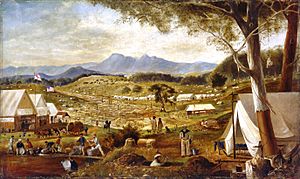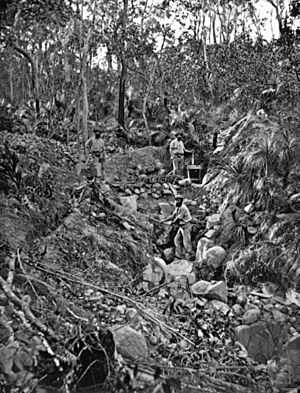Australian gold rush facts for kids

Gold diggings, Ararat, Victoria, by Edwin Stocqueler, 1854
|
|
| Date | May 1851 – c. 1914 |
|---|---|
| Location | Australia |
| Type | Gold rush |
| Theme | Significant numbers of workers (both from other areas within Australia and from overseas) relocated to areas in which gold had been discovered |
| Cause | prospector Edward Hargraves claimed to have discovered payable gold near Orange |
| Outcome | Changed the convict colonies into more progressive cities with the influx of free immigrants; Western Australia joined Federation |
The Australian gold rush was a period when many gold discoveries were made across Australia. During these times, lots of people moved to areas where gold had been found. They came from other parts of Australia and from countries far away.
Before 1851, some gold was found, but the government of New South Wales (which included Victoria back then) kept it a secret. They worried that if people found out, workers would leave their jobs to search for gold. This could make the economy unstable.
But after the California Gold Rush started in 1848, many Australians left for California. The New South Wales government then changed its mind. They decided to allow gold mining and even offered rewards for finding gold. This led to the big gold rushes.
Thousands of people came to Australia hoping to find gold and get rich. The first big rush began in 1851 near Bathurst, New South Wales. The last major rush was in 1893 in Kalgoorlie, Western Australia.
At first, gold was often found easily in rivers and creeks. This was called alluvial gold. Individual miners could find it using simple tools like a spade and a dish. Most of this easy-to-find gold was collected in the first few months.
To get gold buried deeper underground, miners had to work together. They dug tunnels and eventually, large companies were formed. These companies raised money to build deep gold mines.
Contents
The Excitement of the Gold Rush
Gold rushes happened when new alluvial gold was discovered. Miners would quickly move to these new spots. Everyone hoped to be the first to find surface gold.
For example, miners rushed to Clunes, Victoria in August 1851. But they soon moved to Buninyong when they heard of a new discovery. Weeks later, gold was found at Ballarat. Within six weeks, over 10,000 people were digging there. By 1852, many miners had left Ballarat for the new goldfields at Bendigo.
Fighting for Miners' Rights: The Eureka Stockade
In 1854, miners in Ballarat were very unhappy. They had to pay for gold licences, which they felt was unfair. In protest, they burned their licences and raised a flag called the Eureka Stockade flag.
The miners fought against soldiers and police officers to protect their rights. This event is known as the Eureka Stockade. Many people were hurt or died. However, after this protest, the miners no longer had to pay for their licences. This was a big win for them.
Before the Big Gold Rushes
Gold was found in Australia before the main gold rush of 1851. At first, people didn't believe the stories. In 1823, a convict found gold near Bathurst. He was given 150 lashes with a whip because officials thought he must have stolen it.
The explorer Count Paul Strzelecki found gold in the Australian Alps in 1839. The government kept this a secret. They didn't want convicts to run off and search for gold.
Other gold finds before 1851 included:
- Strathloddon, Victoria in 1840
- Hartley, New South Wales in 1844
- Montecute, South Australia in 1846
- Glenmona Station, Victoria (near Maryborough) in 1849
Where Gold Was Found
Gold rushes happened in many different parts of Australia. Here are some of the key locations where gold was discovered.
Gold in New South Wales
New South Wales had the first big gold rush. Many other rushes followed over the next 30 years.
- Ophir, New South Wales, north east of Bathurst, 12 February 1851
- Hill End, 1851
- Tilba Tilba, 1852
- Kiandra, January 1860
- Young, June 1860
- Forbes, June 1861
- Parkes, 1862
- Gulgong in 1870
- West Wyalong, 1893
Gold in Victoria
Victoria became a separate colony in 1851. It quickly became a major gold-producing region.
- Clunes, 28 June 1851
- Warrandyte, at Anderson's Creek, July 1851
- Castlemaine, 20 July 1851
- Buninyong, 2 August 1851
- Ballarat, 8 August 1851
- Bendigo, October 1851
- Beechworth, February 1852
- Yackandandah, May 1852
- Eaglehawk, May 1852
- Omeo, 1852
- Heathcote 1852
- Walhalla, February 1853
- Maldon, June 1853
- Buckland River, July 1853
- Waranga, 3 August 1853
- Creswick, 1853
- Ararat, October 1854
- Daylesford
- Blackwood, February 1855
- St Arnaud, 1855
- Dunnolly
- Tarnagulla
- Moliagul
- Wedderburn, 1852
- Rheola
- Inglewood
- Kingower
- Stawell, 1857
- Chiltern 1858
- Barkly 1859
- Wood's Point, 1862
- Gaffney's Creek
- Jamieson
- Matlock
Gold in South Australia
South Australia also had its own gold discoveries.
- Onkaparinga, October 1852
- Teetulpa, 1886
Gold in Western Australia
Western Australia saw significant gold rushes later in the 19th century.
- Hall's Creek, 1885
- The Pilbara, 1888
- Southern Cross, 1888
- Coolgardie, 17 September 1892
- Kalgoorlie 14 June 1893
Gold in Queensland
Queensland had several important goldfields.
- Rockhampton, 1858
- Gympie, 1867
- Ravenswood, 25 December 1871
- Charters Towers, 1872
- Palmer River, near Cooktown, 1873
- Hodgkinson River, near Cairns, 1875
- Mount Morgan
- Coen, 1878
- Croydon, 1885
Gold in the Northern Territory
The Northern Territory also had a gold rush.
- Pine Creek, 1871
Images for kids
-
A view of the first small village to develop on the Mount Alexander goldfields at Chewton (then known as Forest Creek) near Castlemaine in 1852, painted by Samuel Thomas Gill
-
A chart showing the Great Nuggets of Victoria at Museums Victoria
See also
 In Spanish: Fiebres del oro en Australia para niños
In Spanish: Fiebres del oro en Australia para niños










